The Future of the Largest Buildings: Will They Get Even Bigger?
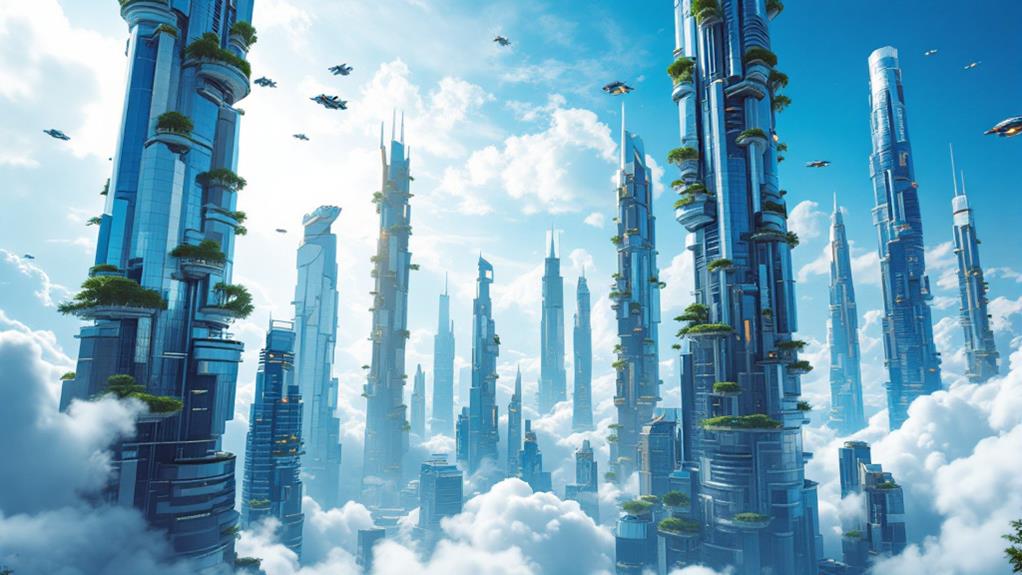
You'll see skyscrapers towering higher as innovations in materials and technology make gigantic structures feasible. Asia is at the forefront, with many of the tallest buildings, like the Jeddah Tower, aiming for record-breaking heights. Advances like self-healing concrete and aerodynamic designs improve strength and sustainability. These structures function as vertical villages, optimizing limited space in crowded cities. With rising land costs, skyscrapers are more attractive for integrating living, working, and social environments. As elevator technology evolves, traveling within these giants becomes more efficient. Curious about how clever engineering and urban design further drive this trend? The insights await.
Evolution of Skyscraper Trends
Skyscrapers' evolution is reshaping the world's urban landscapes, with Asia emerging as the new frontier for towering giants. By 2020, projections indicated that 18 of the 20 tallest buildings would grace this region. This shift highlights Asia's dynamic urban development, where tall buildings play an essential role in addressing the challenges of limited land and high population density. You can see this trend exemplified by the Jeddah Tower in Saudi Arabia, set to outdo the Burj Khalifa as the world's tallest, reaching an astounding 1,000 meters (3,280 feet).
In this competitive skyline race, tall buildings are no longer just architectural marvels; they're becoming vertical villages. These structures integrate residential, commercial, and social spaces, enhancing urban living. You might find yourself living, working, and socializing all within the same towering structure, a reflection of the evolving concept of skyscrapers as self-contained communities. This approach not only optimizes land use but also addresses the soaring costs of urban development.
As cities expand, the demand for groundbreaking solutions grows. Tall buildings stand at the forefront, offering a practical means to accommodate urban growth while transforming cityscapes in unprecedented ways.
Innovations in Building Materials
Considering recent advancements, breakthroughs in building materials are dramatically reshaping the future of skyscrapers. With each development, the potential for constructing taller and more resilient buildings grows. Imagine a world where:
- Composite Materials: These marvels improve skyscraper strength and stability, allowing structures to rise higher while withstanding fierce winds and gravitational pressures.
- Self-Healing Concrete: Picture buildings that repair their own cracks, extending their lifespan and slashing maintenance costs. This technology is not only groundbreaking but also practical for the towering giants of tomorrow.
- 3D Printing: Visualize creating complex architectural forms with precision and efficiency. Emerging 3D printing technologies promise to revolutionize construction, offering new design possibilities and efficient material usage.
Economic Influence on Height
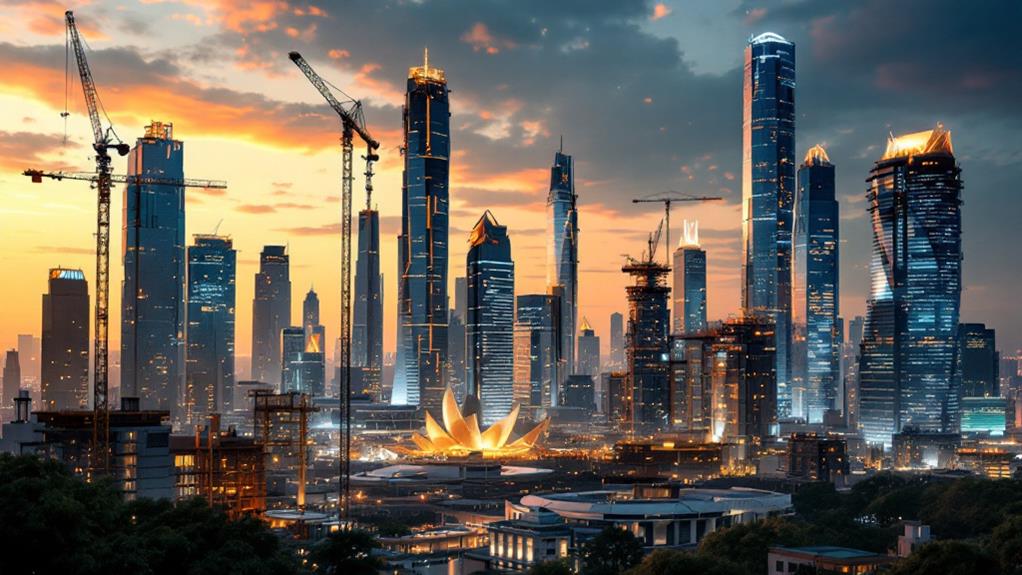
The economic landscape considerably shapes the height of modern skyscrapers. High land costs in dense urban areas drive cities to grow vertically, making tall buildings a practical solution. When you think about it, these towering structures don't just fill the skyline—they increase property values and revitalize neighborhoods, turning them into lucrative investments. As cities continue to evolve, there's a noticeable trend towards mixed-use skyscrapers. These buildings meet the rising demand for spaces where you can live, work, and socialize, all under one roof, improving their economic appeal.
Innovations in construction materials also play a significant role. With advanced composite and concrete blends, the cost of building taller structures decreases while maintaining structural integrity. This makes skyscrapers more economically feasible. In Asia, where urban growth is booming, 18 out of the 20 tallest buildings will be located, highlighting the region's economic investment and development influence.
Moreover, efficient traffic management becomes essential. As these skyscrapers rise, managing the flow of people and vehicles around them is critical. Smart traffic solutions not only improve accessibility but also elevate the economic potential of these vertical giants.
Social Aspects of Vertical Living
In the current urban landscape, the concept of vertical living transforms the way we think about community and lifestyle. Vertical villages aren't just about height; they're about crafting lively, self-contained communities that redefine city life. Here's what makes these towering structures crucial for modern living:
- Integrated Spaces: Imagine living in a building where your home, office, and favorite coffee shop are just floors apart. Vertical villages blend living, working, and social areas to improve convenience and foster a sense of belonging.
- Community Interaction: Picture green terraces and shared spaces designed to encourage interaction. These areas become meeting points where residents connect, building a unique community spirit that's often missing in sprawling urban environments.
- Sustainability Focus: Envision structures that prioritize energy efficiency and green design. Vertical villages incorporate natural elements, reducing carbon footprints while improving the residents' quality of life.
Cities like Singapore lead the way, showing how vertical and horizontal designs can work together to create dynamic urban habitats. By blending these elements, vertical villages not only promote urban development but also nurture social connections in densely populated areas, making them a cornerstone of future city planning.
Integration With Urban Design
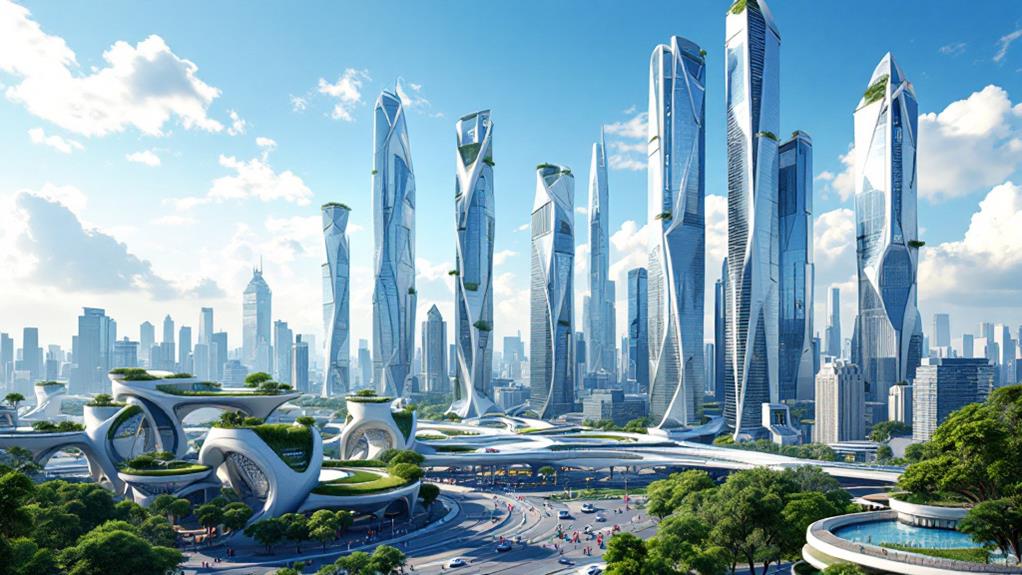
As urban landscapes continue to evolve, integrating skyscrapers into urban design is crucial for creating lively and sustainable cities. You'll find that future skyscrapers are envisioned as vertical villages, seamlessly combining living, working, and social spaces. This integration not only improves the quality of life in densely populated areas but also requires thoughtful urban planning. To achieve this, it's imperative to incorporate green spaces within these towering structures, moving beyond mere decoration to establish authentic ecosystems that support sustainability.
Cities like Singapore lead the way, demonstrating how skyscrapers can blend vertical and horizontal design strategies to elevate urban aesthetics and functionality. By doing so, they set a precedent for other cities aiming to balance development with environmental and social considerations. The concept of urban habitats in the sky emphasizes the significance of community living and social interaction, urging architects to craft designs that foster connectivity among residents.
To create skyscrapers that truly improve urban living, you must adopt a balanced approach. This involves combining vertical growth with environmental stewardship, ensuring that green spaces become integral parts of the cityscape, rather than afterthoughts. By prioritizing these elements, skyscrapers can become dynamic contributors to urban life.
Overcoming Structural Challenges
Pioneering advancements in engineering and materials are transforming the way we tackle structural challenges in skyscraper construction. You're witnessing a revolution where buildings can now exceed one kilometer, like the Jeddah Tower at 1,000 meters. This is achieved by employing groundbreaking techniques that address the immense forces acting on these structures.
Consider these structural marvels:
- Composite Materials: Using modern composites and staggered designs improves stability against wind forces, which can exert about 17 pounds per square meter on skyscrapers. These materials allow for flexibility and strength, vital for super-tall buildings.
- Deep Foundations: Take the Burj Khalifa, for example, which relies on 192 concrete and steel piles buried over 50 meters deep. This foundation prevents sinking and supports the building's massive weight.
- Aerodynamic Designs: They greatly reduce wind resistance. The Shanghai Tower's design, for instance, cuts wind force impacts by up to 25%, showcasing how form follows function in skyscraper engineering.
Along with these, innovations like tuned mass dampers, such as the one in Taipei 101, counteract swaying from lateral winds. These advances collectively guarantee that today's tallest buildings are not just taller but safer and more resilient than ever.
Advances in Elevator Technology
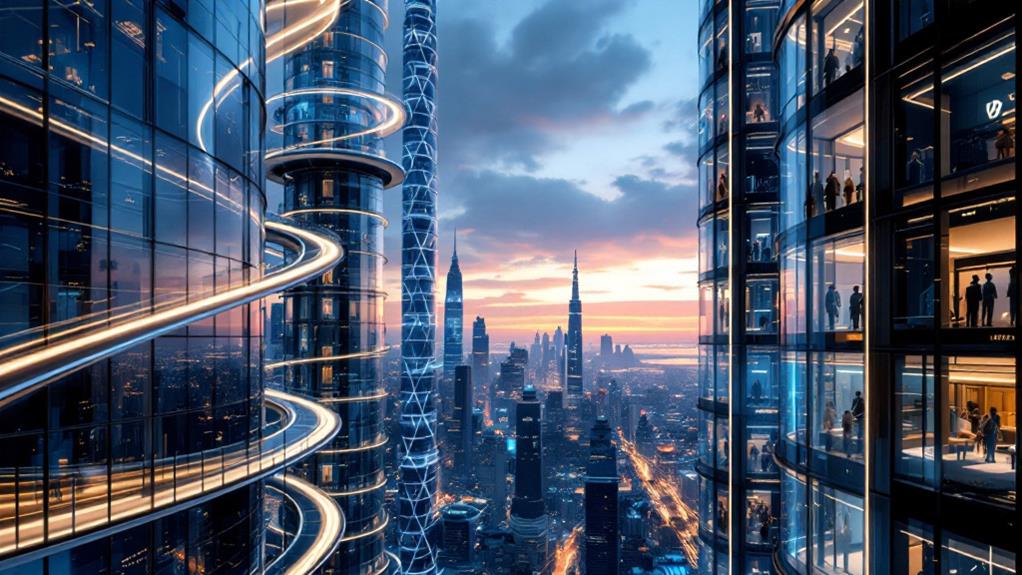
Lift technology is soaring to new heights, transforming how we navigate the world's tallest buildings. Imagine traveling over 70 km/h through a skyscraper, turning what used to be a lengthy trip into a swift ride. This isn't just about speed; it's about efficiency and innovation. Modern lift technology now includes frictionless magnetic rails, promising even faster and smoother rides as you ascend or descend these architectural giants.
But that's not all. Traffic management algorithms are at the forefront of optimizing your lift experience. These algorithms group riders by destination, reducing wait times and ensuring a more streamlined passage. No more long waits or crowded trips—your ride is quicker and more comfortable.
Perhaps one of the most groundbreaking advancements is the rope-less lift system. This technology allows for multi-directional travel, giving you unprecedented flexibility and efficiency. You're no longer limited to just up and down; you can move sideways, too, enhancing how you navigate complex high-rise structures.
As skyscrapers continue to grow taller and more complex, the integration of advanced lift technology becomes crucial. It not only accommodates these changes but also enhances your entire experience.
Environmental Considerations
Considering growing environmental awareness, future skyscrapers are being designed with a strong focus on minimizing their ecological footprints. Architects are prioritizing energy efficiency and carbon footprint reduction by integrating sustainable materials and technologies. To visualize this, picture the following:
- Solar Panels and Wind Turbines: These renewable energy sources power towering structures, reducing reliance on non-renewable energy.
- Vertical Gardens: Imagine lush green spaces woven into the fabric of skyscrapers, enhancing urban biodiversity and improving air quality, much like the vertical gardens in Singapore.
- Water Conservation Systems: Advanced systems like rainwater harvesting and greywater recycling are incorporated to combat resource scarcity in densely populated areas.
These environmental considerations are vital as building heights escalate. Effective waste management systems are fundamental to minimize the ecological impact of large populations concentrated in vertical developments. The design of future skyscrapers not only demands creative approaches to energy and water use but also emphasizes the importance of integrating green spaces. As you envision these massive structures, keep in mind that they reflect a commitment to sustainability, balancing urban growth with the planet's well-being. It's about crafting a future where skyscrapers don't just dominate skylines but also contribute positively to the environment.
Future Prospects and Predictions
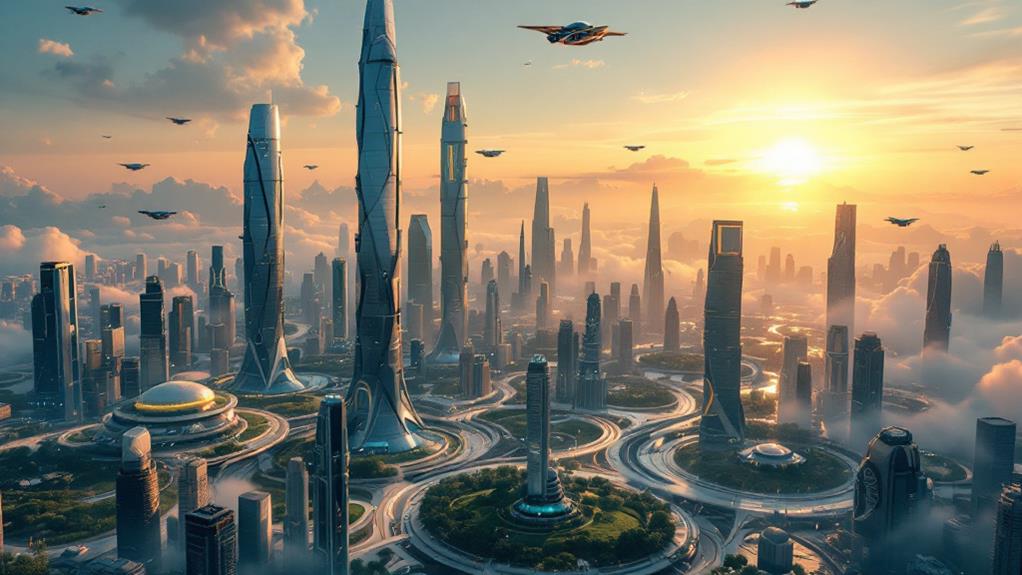
As the focus on sustainability in skyscraper design grows, the possibilities for future buildings appear limitless. You're witnessing a fascinating period where the tallest structures are shifting eastward, with predictions indicating that by 2020, 18 of the 20 tallest buildings will be in Asia. This shift not only marks a change in architectural dominance but also sets the stage for future prospects in skyscraper creativity.
Imagine a skyline dominated by vertical villages, where living, working, and social environments seamlessly blend. This is the future experts predict, with skyscrapers like the Jeddah Tower in Saudi Arabia pushing the boundaries of what's possible. At 1,000 meters, it will surpass the Burj Khalifa, setting new standards for height and design. Advances in engineering, especially with composite materials and structural techniques, are essential for these towering feats, allowing for buildings over a kilometer tall.
The future prospects for skyscraper design also hinge on tackling challenges like stability and environmental impact. Ongoing research into aerodynamics and groundbreaking technologies is key to ensuring these enormous structures are safe and eco-friendly. As these predictions unfold, you're witnessing the dawn of a new architectural period.



